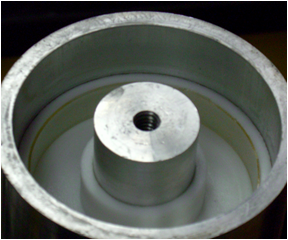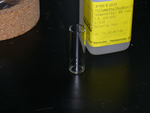
Freeze drying is a technique to remove residual solvent from a material to produce a dry powder that can be easily loaded into a cell. The material is dissolved in benzene and frozen in a dry-ice acetone bath. The benzene sublimates and is removed by vacuum, leaving a dry powder. This technique can be used for both polymer systems as well as mesogen molecules.

- balance
- weighing boat | paper
- glass vial | plastic > 5mL
- glass | plastic transfer pipette
- Teflon film (~20um thick)
- spin casting head
- heated centrifuge | spinning apparatus
- dry-ice | liquid nitrogen
- Tefzel tape (DuPont)
- 15 cm plastic | wood | metal rod for hanging LCE

Pump setup
- A complete pump setup consists of a pump, a cold finger, a cold trap, glass adaptors, and hose connections
- Fill the cold trap half full with acetone then slowly add dry ice. When cool, the solution will no longer strongly bubble. Slowly insert the cold finger into the cold trap.
- Fill the rest of the cold finger with a dry ice acetone.
Procedure
- Transfer the material to a round bottomed flask and dissolve in 3 to 5 mL of benzene.
- Pour ~ 100mL of acetone in the dewar and then add dry ice to cool the acetone. When comlpetely cool, the solution will no longer bubble strongly.
- Swirl the round bottom flask in the dryice / acetone solution. The sample will freeze to the inner surface of flask, forming a thin layer.
- Connect flask to the vacuum pump and pump overnight.
- When complete, the material will be a dry film on the inner surface of the flask. Close the stopcock on the valve adjacent flask and turn off the pump and vent the system to the atmosphere.
- Open the stopcock to the flask. If the material dissolves again, re-dissolve in benzene, freeze and repeat.
- The material may now be transferred to another flask for long term storage. If the material sticks to the glass of flask, place the glass in a dry ice bath or liquid nitrogen, and the material will come easily off of the surface of the glass.
This material is prepared using a heated centrifuge in a spin casting head. Before starting material preparation, pre-heat the spin casting head to 60 ~ 65oC.

The first step is preparation of the catalyst solution and reaction solution

- The platinum catalyst solution is prepared as a 1 to 2% weight/weight (w/w) solution in methylene chloride. Typically, this solution is prepared in quantities of 100 to 200uL in a brown vial and stored in the refrigerator.
- Example calculation for 1% (w/w)solution: Add 2 mg of the platinum catalyst to brown glass vial. Add methylene chloride drop wise until the total mass is 100 mg. This will be enough to prepare 5 batches of LCE













































